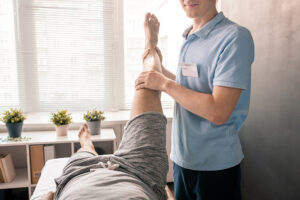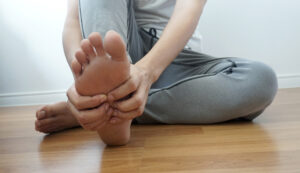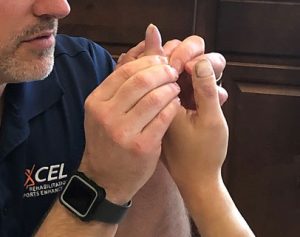Herniated discs can be an incredibly painful and challenging issue to deal with. The pain can range from mild to severe and can have a significant impact on your daily activities and overall quality of life. Herniated discs can happen anywhere in the spine from the neck, to the upper or lower back. They can be caused by a variety of issues, but usually happen from a combination of factors like age, wear and tear, trauma, or lifestyle. Herniated discs affect up to 2% of people each year. The good news is that physical therapy can be beneficial treatments to help heal your herniated disc quickly and safely.
What can physical therapy do for a herniated disc?
Physical therapy can be beneficial if you’re struggling with the pain of a herniated disc. It can help your healing process in several ways, including:
- Pain management — Physical therapy includes techniques and modalities that are intended to help manage pain associated with a herniated disc. Pain relief strategies can help reduce discomfort, improve tolerance to exercises and make it easier for you to do activities.
- Inflammation reduction — Therapeutic modalities can help reduce inflammation around your herniated disc. Reducing inflammation can help tissue healing by reducing pressure on nerves.
- Range of motion — Physical therapy exercises and techniques can help you improve your spinal mobility, reduce stiffness and improve your flexibility in the affected area. Improving your range of motion can help alleviate pressure on your herniated disc and the surrounding area.
- Muscle strength — Therapeutic exercises can help strengthen and stabilize your muscles that help support your spine. Stronger muscles can help provide better spinal support, reduce strain on the disc and improve overall spinal stability.
- Tissue healing — Physical therapy techniques can help improve circulation. Improved circulation can help stimulate healing around a herniated disc, which can help ease symptoms and boost recovery.
Physical therapy offers many benefits to help your herniated disc recovery. Under the guidance of your therapist, you can work to regain function and improve your quality of life.
Physical therapy treatments for a herniated disc
Physical therapy can play a vital role in the treatment of your herniated disc. Some common PT treatments for a herniated disc include:
- Manual therapy — Manual therapy techniques are hands-on techniques used by physical therapists. These techniques help improve joint mobility, reduce pain, boost tissue healing and restore optimal function. Manual therapy modalities can include soft tissue mobilization, joint mobilization, myofascial release and trigger point therapy. Soft tissue mobilization involves applying manual pressure to muscles, tendons, ligaments and fascia. This can help reduce muscle tension, improve flexibility and promote healing. Joint mobilization involves gentle, controlled movements applied to the spinal joints or surrounding joints. These movements can help up to 73% of people improve mobility, reduce stiffness and alleviate pain. Myofascial release helps target the connective tissue, or fascia, that surrounds and supports muscles, nerves, and organs. Your therapist will use gentle sustained pressure, stretching or rolling movements to help release fascial restrictions. This can help improve tissue mobility and overall movement. Trigger points are spots of muscle tightness or “knots.” These troublesome spots can cause pain and limit motion. Your therapist will apply pressure to these trigger points to help release the tension, improve blood flow and help reduce pain.
- Nerve gliding exercises — Nerve gliding focuses on improving the mobility and function of the nerves that may be compressed or irritated because of a herniated disc. Your physical therapist will perform controlled movements to the spine or affected limb to gently stretch and mobilize your nerves. This can help reduce nerve sensitivity, tingling, numbness or radiating pain that can be associated with sciatica or nerve root compression.
- Postural correction — Bad posture can contribute to weak muscles and imbalances, which can play a part in the development of herniated discs because of the strain on the back. Your therapist can assess and address your imbalances, weaknesses and movement dysfunctions. These can be causing your herniated disc or making symptoms worse. Using proper posture, body mechanics and ergonomics can help reduce and prevent strain on your back, reducing the risk of herniated discs and improving your overall long-term back health.
- Therapeutic exercises — Your physical therapist may create a therapeutic exercise or stretching program to do in the clinic or at home. These stretches and exercises can help keep up your healing progress by targeting various muscles that may be affected by your herniated disc and pain. Strengthening your core muscles is essential to help stabilize your spine and reduce strain on the disc. Stretching exercises can help ease tight muscles to improve flexibility, reduce stiffness and alleviate pressure on your spine. Your therapist may also recommend low-impact cardiovascular exercises like walking, cycling or swimming to boost your physical fitness without adding excessive strain to your back. Low-impact exercises like walking can be good to help with a herniated disc. However, some people may find that walking makes their pain or discomfort worse. It’s important to listen to your body and stop or avoid activities that make you feel worse.
- Dry needling — Dry needling is a technique used by certified physical therapists. It involves inserting thin, sterile needles into trigger points or tight muscles in the back or affected areas. It can help stimulate a healing response, relieve pain, boost circulation and enhance the effectiveness of other techniques. It can be beneficial for you if you are dealing with muscle tension or spasms with your herniated disc.
- Instrument-assisted soft tissue mobilization (IASTM) — IASTM is a technique involving specially designed stainless steel or plastic tools. Physical therapists use these tools to apply controlled pressure and friction to targeted soft tissue. It can help break down scar tissue, adhesions and fascial restriction. It is intended to help promote tissue healing, improve mobility, enhance the effectiveness of stretching and strengthening exercises, reduce inflammation, and provide pain relief.
During your physical therapy sessions, it’s important to communicate openly with your therapist. Let them know if anything is making your pain and discomfort worse. Follow their recommendations and instructions to ensure that you are doing exercises and stretches correctly. To get the most out of your rehabilitation, you have to take an active part.
How long does it take to heal from a herniated disc?
Healing from a herniated disc can be a gradual process, but usually takes a few weeks to start feeling better. Signs of healing can vary from person to person. Common signs of healing include:
- Reduced pain — One of the primary signs that your herniated disc is healing is a reduction in the intensity and frequency of your pain. It can diminish overtime and become more manageable or intermittent as your disc heals.
- Improved mobility — As the inflammation and swelling go down around the herniated disc, you may see an improvement in your range of motion and flexibility. Activities like bending, twisting or lifting that had been difficult or painful may become easier to do.
- Decreased numbness or tingling — If your herniated disc was causing nerve compression and you were experiencing numbness, tingling or weakness in certain areas like your legs or arms, you may see this lessen or disappear as the nerve irritation improves.
- Reduced medications — As your pain levels drop and your symptoms improve, you may need less pain medication or anti-inflammatory drugs to manage your discomfort. However, it’s crucial to remember to always discuss starting or ending medications with your health care provider.
- Return to normal — As you heal from a herniated disc, you may gradually return to your normal activities and movements without having significant pain or limitations. You may see a gradual improvement in your ability to do daily tasks, work responsibilities and recreational activities.
- Stability and strength — Therapeutic exercises prescribed by your physical therapist can help stabilize your spine, improve your muscle strength and support your body’s natural healing process. As your muscles become stronger, you may see a greater stability and reduced risk of having a herniated disc again. These exercises can also help improve your posture and body mechanics to provide additional healing and spinal support.
Healing from a herniated disc is a multifaceted process. Progress requires patience, consistency with treatment recommendations in the clinic and at home, and ongoing monitoring by health care professionals. You should check in with your physical therapist to track your progress, address concerns and make adjustments as needed to your treatment plan.
Experience the Excel Rehab & Sports difference to boost your herniated disc recovery
At Excel Rehab & Sports, we always take a patient-first approach. We emphasize continuity of care during your treatment, and you’ll work with the same physical therapist through your treatment process. This continuity helps develop a strong therapeutic relationship, promotes better communication, and allows for tailored interventions based on your personal progress and needs. We prioritize your comfort, progress and long-term recovery by challenging you in our uplifting and supportive environment to help guide you toward restored mobility, reduced pain and improved quality of life as you heal from your herniated disc.
Call us or request an appointment today to start your journey to relief from herniated disc pain.




